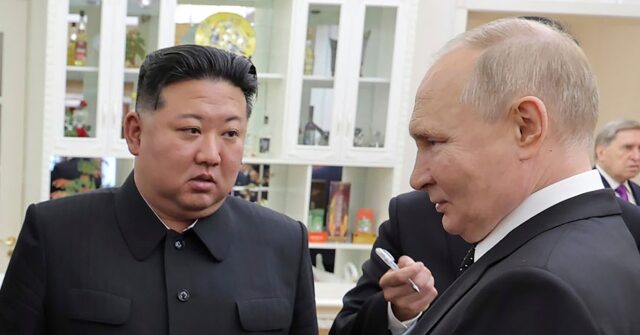Recent reports from South Korea’s Joint Chiefs of Staff (JCS) indicate that North Korea is intensifying its military support for Russia amid the ongoing conflict in Ukraine. North Korean leader Kim Jong-un is reportedly keen on sending more military assets, including “suicide drones,” to bolster Russian President Vladimir Putin’s war efforts. South Korean military intelligence refers to directives from Kim encouraging increased production of these drones, envisioning that their deployment in Ukraine may provide valuable battlefield experience for North Korean forces, who have struggled against Ukrainian drone technology.
The collaboration between North Korea and Russia includes the transfer of various military hardware. South Korean assessments highlight that North Korea is set to augment troop deployments and supply significant armaments, including 240mm rocket launchers and 170mm self-propelled artillery. Observations from Ukrainian defense researcher Andriy Tarasenko suggest that North Korea has already delivered medium-range ballistic missiles, such as the M1989 Koksan and Pukguksong-2, capable of striking targets over 1,200 miles away. However, performance issues were noted in recent test launches of these missiles, raising questions about the reliability of such systems in a combat scenario.
As the war progresses, North Korea’s contribution to Russia’s arsenal has grown substantially. Ukrainian officer Andriy Kovalenko noted that an estimated 60 percent of the artillery and mortar shells used by Russian forces are supplied by North Korea. Notably, the more recent shipments include factory-fresh munitions, a significant upgrade from earlier consignments of older ordnance. Ukrainian officials have expressed concern over the imprecision of North Korean missiles despite their impressive range, underlining the heightened threat to civilian populations in Ukraine as Russia enhances its artillery capabilities with North Korean assistance.
Kim Jong-un’s regime appears to be investing heavily in its military infrastructure, as satellite imagery suggests rapid expansion at missile production facilities on North Korea’s eastern coast. Analysts remark that in addition to receiving North Korean weaponry, Russia has compensated North Korea with substantial financial resources—estimated at up to $5.5 billion since February 2022—coupled with upgrades to improve North Korea’s dated air-defense systems. Financial flows include remuneration for North Korean mercenaries deployed in the conflict, which adds a reported $572 million annually to the regime’s coffers.
Despite the clear evidence of arms transfers, both the Russian and North Korean governments have publicly denied significant shipments of weapons or troop movements. The Russian authorities have taken measures to obscure the casualties among North Korean mercenaries on the battlefield, working to remove injured or deceased personnel from public scrutiny. This clandestine approach reflects the delicate nature of the alliance and the dire implications of publicizing North Korean casualties at a time when morale and operational integrity are crucial for the Russian military.
Adding to these developments, the South Korean JCS issued warnings about North Korea’s reinforcement of its border with South Korea, transforming the demilitarized zone into a heavily fortified zone. This militarization includes electric fencing and various barriers, emphasizing Kim’s intent to fortify the military position against perceived threats from the south. Experts caution that under the aegis of Russian support, North Korea may look to stage strategic provocations in the coming year, such as intercontinental ballistic missile launches or even nuclear tests, to bolster its negotiating power with the United States and solidify its military standing in the region.

